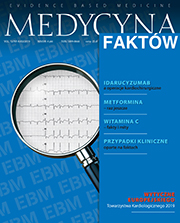Co nowego w wytycznych Europejskiego Towarzystwa Kardiologicznego 2019? Wytyczne dotyczące diagnostyki i leczenia przewlekłych zespołów wieńcowych Artykuł przeglądowy
##plugins.themes.bootstrap3.article.main##
Abstrakt
Nowe wytyczne ESC dotyczące przewlekłych zespołów wieńcowych zainicjowały zmiany dotyczące zarówno diagnostyki, jak i leczenia wspomnianej grupy chorych. Wprowadzono określenie klinicznego prawdopodobieństwa choroby, które determinuje odpowiedni dobór metody diagnostycznej. Najnowsze zalecenia kładą nacisk na diagnostykę nieinwazyjną, w tym przede wszystkim TK naczyń wieńcowych, zmniejszając przy tym istotnie rolę testu wysiłkowego. W farmakoterapii ukazano korzyści intensywnego leczenia przeciwkrzepliwego, zwiększając znaczenie nowych doustnych leków przeciwkrzepliwych, w tym przede wszystkim rywaroksabanu w małej dawce w podwójnym leczeniu z kwasem acetylosalicylowym. Ponadto wzmocniono rolę ezetymibu oraz nowych leków przeciwcukrzycowych – inhibitorów SGLT2 oraz antagonistów GLP-1.
##plugins.themes.bootstrap3.article.details##
Copyright © by Medical Education. All rights reserved.
Bibliografia
2. Montalescot G., Sechtem U., Achenbach S. et al.: 2013 ESC guidelines on the management of stable coronary artery disease: the Task Force on the management of stable coronary artery disease of the European Society of Cardiology. Eur. Heart J. 2013; 34: 2949-3003.
